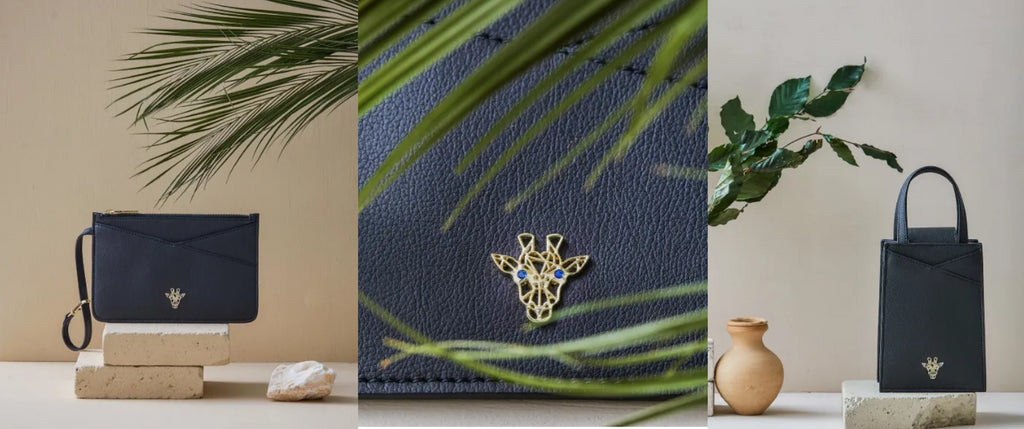3 Things To Know About Vegan Leather And Cruelty-Free Alternatives To Animal Leather
Posted by FABIANA GONZALEZ

Vegans who love a rocker/biker aesthetic rejoice – vegan leather is becoming more and more ubiquitous and varied. Nowadays, pineapple waste can be transformed into a trendy leather handbag and cork can be made into your Grease-esque grunge get-up. Here, we dispel the rumours surrounding cruelty-free leather – Is faux leather always more sustainable than animal leather? No, not really – and give you the lowdown on the ingenious vegan leather technologies hitting the market.
What is vegan leather?
Vegan leather is leather that imitates the appearance and feel of treated animal hides without any creatures being harmed. Synthetic leather made of polyurethane (PU) and polyvinyl chloride (PVC) have long been popular choices among designers for their easy customizability and cheap price. However, these are also not ideal because they are not biodegradable. These faux leathers take a long time to decompose and release toxins in landfill, trading one eco-evil for another.
The term ‘faux leather’ is now coming to represent a distinguishing between plastic leather and that made from more organic, biodegradable sources like fruit or cork tree.
What's the difference between vegan leather vs animal leather?

Traditionally, cows, sheep, and alligators have been slaughtered for human wearing. Not only this, but animal skins require great amounts of water, energy and chemicals to be processed into what we recognize as usable leather. Waste materials produced by tanneries, where animal leather processing occurs, contain pollutants like lime sludge and acids. In short, both the earth and its creatures are adversely impacted by the conventional leather industry.
In contrast, ethically sourced leathers don’t require any animals to die and also have a more environmentally-friendly post-consumer life. Plant-based leathers like a coconut leather masterminded by an Indian start-up breaks down within 150 days, compared to PU leather’s 500 years.
These low-impact derivatives are made from a library of organic materials, including mushroom, corn, banana, cactus, leaves and cork. They are often even made from agricultural waste. While most vegan leathers don’t boast the same durability as traditional leather, certain alternatives like those made from mushroom are relatively long-lasting.
What are the types of vegan leather?

There are multiple vegan-friendly options that don’t include a plastic sheen. Here are six leather alternatives that will align with cruelty-free and earth-conscious shoppers’ values.
Cactus leather
Cactus leather is made from the fast-growing prickly pear cactus. Harvesting occurs only twice a year, cutting only mature cactus leaves, so the plant can continue to grow. This cruelty-free leather is more breathable than other animal skin alternatives, making it a popular vegan sustainable handbag and clothing material.
Banana leather
Banana leather is made from banana fibre waste. These agricultural by-products are normally left on the ground to biodegrade. However, this type of animal-free leather can deprive water-residing animals of oxygen if incorrectly disposed of. Furthermore, there are more sustainable options as banana trees are only harvested once in their lifespan.
Piñatex leather
Piñatex is made from pineapple leaves. Approximately 76 million tons of these leaves are produced each year. The leather-like fabric was first invented by a professor at London’s Royal College of Art. While worlds more eco-friendly than animal skin, pineapple leather has low biodegradability compared to some other types of ethical leather.

Vegan cork leather
Cork leather is made from an evergreen native to Southwest Europe and Northwest Africa: the Quercus suber. The tree itself is credited for the ability to offset greenhouse gas emissions by locking up CO2 in its wood. Cork leather is lightweight, flexible, soft and hypoallergenic.
Mushroom leather
Another bio-based ethically sourced leather, this one is made from mycelium, which are like the root systems of mushrooms. What results is a supple material not unlike suede. The downfall of mushroom leathers are that they are not fully biodegradable because their components include plastic.
Apple leather
Apple leather is made from the fruit’s peels and pomace (i.e. solid remains of fruit after pressing) from the juice and apple sauce industry. Similar to Piñatex and bananas, this type of cruelty-free leather is a highly renewable resource with low CO² impact.
Conclusion
There are even more leather alternatives that haven’t been mentioned here, such as leaf leather, kombucha leather, and leather made from grains. While the journey towards making non-animal leather as durable as traditional leather continues, it’s undeniable that there are more and more options for animal-conscious shoppers becoming available.
FAQ about vegan leather
What is vegan leather made from?
Ethically sourced leather can be made from a variety of plant and fruit materials, not just polyurethane. These range anywhere from cacti and pineapple to cork and rescued plastic bottles.
What are the most eco-friendly vegan leathers?
Cork leather is a renewable leather resource. This material is extracted from cork oak trees without felling or damaging the native tree. Apple leather is made of from purely food waste and is highly durable.
Is all cruelty-free leather sustainable?
Not all ethical leathers are built the same. Faux leathers made from artificial products like PU and PVC (plastic, in essence) actually take longer than animal leathers to naturally decompose. If comparing the sustainability of vegan leathers, these should be avoided.
Sources:- https://www.thebetterindia.com/227280/kerala-startup-malai-vegan-leather-coconut-water-biodegradable-sustainable-innovation-gop94/
- https://www.sailrite.com/Faux-Leather-Better-Than-Real

👾👾ระบบการเงินมั่นคง ปลอดภัยสูงสุด ด้วยเทคโนโลยีเข้ารหัสขั้นสูง👾👾 On
https://www.paiklangna.com/
https://github.com/dashpradeep99/https-github.com-miguellgt-books/issues/6
https://github.com/defunkt/ambitious_activeldap/issues/14
https://github.com/HoyDiamond/DiamondSeo01/issues/1
https://github.com/gzc/isystem/issues/1
https://github.com/SaeruHikari/SakuraEngine-Old/issues/3
https://github.com/xyba1337/ValorantEZTS/issues/3
https://github.com/henryjeff/portfolio-website/issues/16
https://github.com/HoyDiamond/DiamondSeo01/issues/2
https://github.com/qw3rtman/p/issues/35
https://github.com/cy4nguy/PythonSimpleKeylogger/issues/3
https://github.com/qianjiahao/MongoDB/issues/2
https://github.com/Programming-from-A-to-Z/A2Z-F15/issues/31
https://github.com/u21h2/nacs/issues/13
https://github.com/rafaballerini/GitTutorial/issues/200
https://github.com/Yalantis/uCrop/issues/948
https://diamondlnwpg168.com/
https://github.com/Programming-from-A-to-Z/A2Z-F15/issues/30
https://github.com/openai/sparse_attention/issues/13
♣️♥️คัดมาแล้ว เว็บสล็อตไม่ผ่านเอเยนต์ที่ดีที่สุด 2025♣️♥️ On
https://github.com/defunkt/ambitious_activeldap/issues/14
https://github.com/openai/sparse_attention/issues/13
https://github.com/dashpradeep99/https-github.com-miguellgt-books/issues/6
https://github.com/HoyDiamond/DiamondSeo01/issues/1
https://github.com/cy4nguy/PythonSimpleKeylogger/issues/3
https://github.com/gzc/isystem/issues/1
https://github.com/SaeruHikari/SakuraEngine-Old/issues/3
https://github.com/xyba1337/ValorantEZTS/issues/3
https://github.com/henryjeff/portfolio-website/issues/16
https://github.com/HoyDiamond/DiamondSeo01/issues/2
https://github.com/qianjiahao/MongoDB/issues/2
https://github.com/u21h2/nacs/issues/13
https://github.com/Programming-from-A-to-Z/A2Z-F15/issues/31
https://github.com/qw3rtman/p/issues/35
https://github.com/rafaballerini/GitTutorial/issues/200
https://github.com/Yalantis/uCrop/issues/948
https://www.paiklangna.com/
https://diamondlnwpg168.com/
♣️♥️คัดมาแล้ว เว็บสล็อตไม่ผ่านเอเยนต์ที่ดีที่สุด 2025♣️♥️ On
https://github.com/Programming-from-A-to-Z/A2Z-F15/issues/30
https://github.com/defunkt/ambitious_activeldap/issues/14
https://github.com/openai/sparse_attention/issues/13
https://github.com/dashpradeep99/https-github.com-miguellgt-books/issues/6
https://github.com/HoyDiamond/DiamondSeo01/issues/1
https://github.com/cy4nguy/PythonSimpleKeylogger/issues/3
https://github.com/gzc/isystem/issues/1
https://github.com/SaeruHikari/SakuraEngine-Old/issues/3
https://github.com/xyba1337/ValorantEZTS/issues/3
https://github.com/henryjeff/portfolio-website/issues/16
https://github.com/HoyDiamond/DiamondSeo01/issues/2
https://github.com/qianjiahao/MongoDB/issues/2
https://github.com/u21h2/nacs/issues/13
https://github.com/Programming-from-A-to-Z/A2Z-F15/issues/31
https://github.com/qw3rtman/p/issues/35
https://github.com/rafaballerini/GitTutorial/issues/200
https://github.com/Yalantis/uCrop/issues/948
https://www.paiklangna.com/
https://diamondlnwpg168.com/
♣️♥️คัดมาแล้ว เว็บสล็อตไม่ผ่านเอเยนต์ที่ดีที่สุด 2025♣️♥️ On
https://github.com/Programming-from-A-to-Z/A2Z-F15/issues/30
https://github.com/defunkt/ambitious_activeldap/issues/14
https://github.com/openai/sparse_attention/issues/13
https://github.com/dashpradeep99/https-github.com-miguellgt-books/issues/6
https://github.com/HoyDiamond/DiamondSeo01/issues/1
https://github.com/cy4nguy/PythonSimpleKeylogger/issues/3
https://github.com/gzc/isystem/issues/1
https://github.com/SaeruHikari/SakuraEngine-Old/issues/3
https://github.com/xyba1337/ValorantEZTS/issues/3
https://github.com/henryjeff/portfolio-website/issues/16
https://github.com/HoyDiamond/DiamondSeo01/issues/2
https://github.com/qianjiahao/MongoDB/issues/2
https://github.com/u21h2/nacs/issues/13
https://github.com/Programming-from-A-to-Z/A2Z-F15/issues/31
https://github.com/qw3rtman/p/issues/35
https://github.com/rafaballerini/GitTutorial/issues/200
https://github.com/Yalantis/uCrop/issues/948
https://www.paiklangna.com/
https://diamondlnwpg168.com/
Diamond168ยินดีต้อนรับ On
https://scrapbox.io/DIAMOND16/Diamond168
https://diamondlnwpg168.com/
https://github.com/Programming-from-A-to-Z/A2Z-F15/issues/30
https://github.com/defunkt/ambitious_activeldap/issues/14
https://github.com/openai/sparse_attention/issues/13
https://github.com/dashpradeep99/https-github.com-miguellgt-books/issues/6
https://github.com/HoyDiamond/DiamondSeo01/issues/1
https://github.com/cy4nguy/PythonSimpleKeylogger/issues/3
https://github.com/gzc/isystem/issues/1
https://github.com/SaeruHikari/SakuraEngine-Old/issues/3
https://github.com/xyba1337/ValorantEZTS/issues/3
https://github.com/henryjeff/portfolio-website/issues/16
https://github.com/HoyDiamond/DiamondSeo01/issues/2
https://github.com/qianjiahao/MongoDB/issues/2
https://github.com/u21h2/nacs/issues/13
https://github.com/Programming-from-A-to-Z/A2Z-F15/issues/31
https://www.paiklangna.com/
https://github.com/rafaballerini/GitTutorial/issues/200
https://github.com/Yalantis/uCrop/issues/948